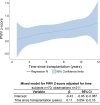Arterial stiffness and blood pressure increase in pediatric kidney transplant recipients
- PMID: 36094669
- PMCID: PMC9925540
- DOI: 10.1007/s00467-022-05611-4
Arterial stiffness and blood pressure increase in pediatric kidney transplant recipients
Abstract
Background: Pulse wave velocity (PWV) is a measure of arterial stiffness. We investigated PWV and blood pressure (BP) to determine to what extent BP changes contribute to arterial stiffness, and secondly, to identify influencing factors on BP in children after kidney transplantation.
Methods: Seventy children ≥ 2.5 years post-transplantation with at least two PWV measurements were included. Changes of systolic (Δ SBP) and diastolic BP (Δ DBP) were classified into "stable/decreasing," "1-10 mmHg increase," and " > 10 mmHg increase." Linear mixed modeling for PWV z-score (PWVz) adjusted either for Δ SBP or Δ DBP was performed. An extended dataset with monthly entries of BP, immunosuppression, and creatinine was obtained in 35 participants over a median of 74 months to perform linear mixed modeling for SBP and DBP.
Results: PWVz increased with a rate of 0.11/year (95% CI 0.054 to 0.16). Compared to participants with stable BP, those with 1-10-mmHg SBP and DBP increase showed a higher PWVz of 0.59 (95% CI 0.046 to 1.13) and 0.86 (95% CI 0.43 to 1.30), respectively. A > 10-mmHg BP increase was associated with an even higher PWVz (SBP β = 0.78, 95% CI 0.22 to 1.34; DBP β = 1.37, 95% CI 0.80 to 1.94). Female sex and participants with lower eGFR showed higher PWVz. In the extended analysis, DBP was positively associated with cyclosporin A and everolimus trough levels.
Conclusions: A higher increase of PWV is seen in patients with greater BP increase, with higher cyclosporin A and everolimus trough levels associated with higher BP. This emphasizes the role of BP as a modifiable risk factor for the improvement of cardiovascular outcome after transplantation. A higher resolution version of the Graphical abstract is available as Supplementary information.
Keywords: Arterial hypertension; Arteriosclerosis; Cardiovascular disease; Chronic kidney disease; Pulse wave velocity; Transplantation.
© 2022. The Author(s).
Conflict of interest statement
The authors declare no competing interests.
Figures




Similar articles
-
Findings from 4C-T Study demonstrate an increased cardiovascular burden in girls with end stage kidney disease and kidney transplantation.Kidney Int. 2022 Mar;101(3):585-596. doi: 10.1016/j.kint.2021.11.032. Epub 2021 Dec 21. Kidney Int. 2022. PMID: 34952099
-
Aortic Stiffness, Ambulatory Blood Pressure, and Predictors of Response to Antihypertensive Therapy in Hemodialysis.Am J Kidney Dis. 2015 Aug;66(2):305-12. doi: 10.1053/j.ajkd.2015.01.018. Epub 2015 Mar 25. Am J Kidney Dis. 2015. PMID: 25818679 Clinical Trial.
-
Central blood pressure and pulse wave velocity in young and middle-aged Japanese adults with isolated systolic hypertension.Hypertens Res. 2020 Mar;43(3):207-212. doi: 10.1038/s41440-019-0364-x. Epub 2019 Nov 29. Hypertens Res. 2020. PMID: 31784679
-
Aortic stiffness after living kidney donation: a systematic review and meta-analysis.BMJ Open. 2024 Dec 5;14(12):e082725. doi: 10.1136/bmjopen-2023-082725. BMJ Open. 2024. PMID: 39638601 Free PMC article.
-
Impact of living kidney donation on blood pressure and arterial stiffness: Systematic review and meta-analysis.PLoS One. 2025 May 30;20(5):e0325390. doi: 10.1371/journal.pone.0325390. eCollection 2025. PLoS One. 2025. PMID: 40446080 Free PMC article.
Cited by
-
Assessment of obesity in pediatric kidney transplant recipients: an ongoing challenge.Pediatr Nephrol. 2025 Jul;40(7):2113-2116. doi: 10.1007/s00467-025-06706-4. Epub 2025 Feb 6. Pediatr Nephrol. 2025. PMID: 39912908 No abstract available.
References
-
- Urbina EM, Williams RV, Alpert BS, Collins RT, Daniels SR, Hayman L, Jacobson M, Mahoney L, Mietus-Snyder M, Rocchini A, Steinberger J, McCrindle B. Noninvasive assessment of subclinical atherosclerosis in children and adolescents: recommendations for standard assessment for clinical research: a scientific statement from the American Heart Association. Hypertension. 2009;54:919–950. doi: 10.1161/HYPERTENSIONAHA.109.192639. - DOI - PubMed
Publication types
MeSH terms
Substances
LinkOut - more resources
Full Text Sources
Medical
Research Materials
Miscellaneous

